|
Lipolysis in adipocytes, the hydrolysis of triacylglycerol (TAG) to release fatty acids (FAs) and glycerol for use by other organs as energy substrates, is a unique function of white adipose tissue. Lipolysis is under tight hormonal control. During fasting, catecholamines, by binding to Gs-coupled-adrenergic receptors (-AR), activate adenylate cyclase (AC) to increase cAMP and activate protein kinase A (PKA). PKA phosphorylates target protein such as hormone-sensitive lipase (HSL) and perilipin 1 (PLIN). PLIN phosphorylation is a key event in the sequential activation of TAG hydrolysis involving adipose triglyceride lipase (ATGL), HSL, and monoglyceride lipase (MGL). During the fed state, insulin, through activation of phosphodiesterase-3B (PDE-3B), inhibits catecholamine-induced lipolysis via the degradation of cAMP.
|
 Regulation of lipolysis in adipocytes - Reference pathway
Regulation of lipolysis in adipocytes - Reference pathway

 Regulation of lipolysis in adipocytes - Reference pathway
Regulation of lipolysis in adipocytes - Reference pathway

